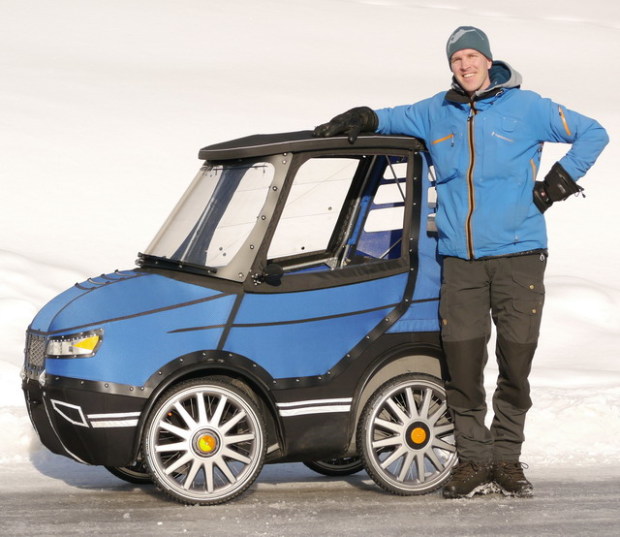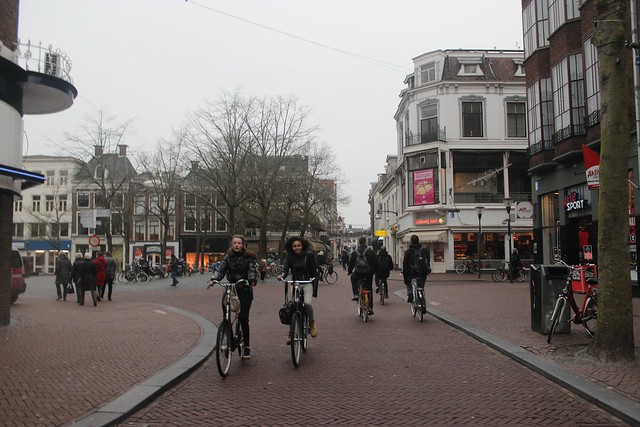There’s something about the simplicity of the bicycle that seems to make everybody want to improve it.
Kickstarter is filled with bike ideas, from bizarre bike lights to bizarre bike carriers to bizarre bike blankets (yes, that’s a thing). There’s nothing inherently wrong with this — most industries would kill for this spirit of innovation. But something about bikes also seems to breed ideas that contravene the old adage of innovation: If it ain’t broke, don’t fix it.
Case in point: This so-cute-that-it-crosses-over-into-ridiculous bike that looks like a car. Called the PodRide by its inventor, a Swedish dude named Mikael Kjellman who has already raised tens of thousands of dollars on Indiegogo, this contraption is basically a recumbent bicycle covered with fabric.

Kjellman, by all accounts a clever and well-meaning guy, says he invented the PodRide to help beat the Swedish winters (there’s a heater inside) and to take advantage of “the environmental benefits these vehicles could have if they were made more popular.” The invention has been making the Facebook rounds these days, mostly, I would argue, because the thing is so damn adorable.
But as a practical idea? The world has already figured out how to keep riding year round: By building safe bike infrastructure, maintaining it for the winter, and dressing for the weather (in fact, somebody, ahem, wrote a book about winter cycling). It’s not rocket science
In fact, I’d argue the PodCar may actually set back the cause Kjellman is purporting to further. Not only does this thing perpetuate the notion that riding in winter is something abnormal that requires special gear, it also creates the impression that bicycles would be a more practical transportation option if they were just a little bit more like cars.
In the big scheme of things, I hardly think the PodCar is a major threat. But there are other ideas out there that perpetuate the idea that cycling is in need of some kind of tech or design fix that really could set back the cause of urban cycling around the world.
Cycling seems to lend itself to giant hare-brained architectural ideas (particularly in London), like the SkyCycle, the floating bike lane dubbed the Thames Deckway, and the bike routes running through abandoned subway tunnels. All of which sure look futuristic in the renderings, but seem to sidestep the reality that cycling isn’t just about transportation — putting bikes on a street makes cities better for everybody because it brings a more human scale to the streets.
Even smaller projects, like this lusted-over airbag helmet or these concept bicycle designs that seem to draw eyeballs at all the bike bike-industry trade shows may seem well and good, but they aren’t exactly furthering the cause of getting more people in cities on bikes.
https://www.youtube.com/watch?v=CMAhptqk-4Q
And despite my soft spot for Elon Musk, and his heartening talk about the urban transportation problem, his recent hint that he’s working on some kind of autonomous bus seems to be a solution for a problem that has already been fixed. If it is, as the speculation goes, some of kind of vehicle to transport people to and from transit stops, also known as the first mile/last mile problem, well, such a vehicle has already been invented. It’s called a bicycle.
Here’s the thing: We already know what works. Bikes haven’t changed much in 100 years because they work. Separated and safe bike lanes work. Want an innovation that will really disrupt the bicycle industry? Invent something to break through civic politics and bureaucracy preventing more bike lanes from being built.
I’m not saying we shouldn’t innovate. E-bikes, cargo bikes and carbon builds have all shown massive improvements in recent years. But let’s not get distracted on frivolities.
Or at least put your innovative brain power into stuff like this or this. At least the ride will be enjoyable.

I’m reading Saskatoon author Yann Martel’s recent book, The High Mountains of Portugal. In Part 1 set in 1904 Tomas, a museum curator, goes on a quest to find a historical artifact in the high mountains and due to a lack of time is encouraged by his wealthy uncle to take the recently innovated automobile. Martel has a few instructive words about the simplicity of the bicycle that was evolving at the same time as the auto saying that it is too dangerous to ride in the hills of Lisbon. The auto in comparison is a complex hulking machine that adds much stress to Tomas’ journey with its Italian manual and the chaos the machine causes in his travels. Men in particular are drawn to the complexity of the auto and the many interacting systems required to keep the machine working. I wonder if the high complexity and challenges of making these systems effective is part of what attracts people to cars over bikes. In the book the auto causes Tomas lots of heartache and I suspect a bike would have got him to his quest faster but the auto creates a story that is fraught with challenges. Auto manufacturers have put enormous energy into reducing complexity and this has led to humans adding complexity with distractions of telephones, texting and maintaining Instagram accounts while operating the machine. Perhaps our minds desire not to be bored and to create adventure is what drives the cycling industry to create more complex features on bikes? I for one enjoy the simple “Zen” of riding a simple machine. My single speed bike is my favorite ride. The KISS (Keep It Simple Stupid) Principle favours the bicycle over the car. I’m still reading Martel’s book and look forward to seeing how Tomas’ quest goes.
What a wonderful comment David. Thanks so much for sharing. I totally agree with the KISS principal of bikes. I love that they are still mechanical, and can still be fixed by (almost) anybody. That’s one of the reasons I’m wary of electronic shifters. But I’m also wary of the burdens of maintenance, so if they can reduce the amount of time you need to think about fixing your bike, I say bring ’em on.
Our world is shifting from one where a person had to know how to take care of yourself to a world where we are largely reliant on specialists. I like bicycles because with a few simple tools (I go to Good Life and share their more complicated ones) I can maintain and fix my own bike. If only there was a Good Life appliance repair shop! Then again I don’t love my appliances as much as my bike.
Ultralight Electric Vehicles are not gimmicks. Maybe you just don’t get it.
Riding a bicycle in a rain is a step too far for many. Snow and ice require winter tires to ride safely and even that can be a hard sell.
Personally, I don’t necessarily want to deal with donning special gear required to stay dry (e.g. shoe covers) and when it pours you’ll still get wet in places. For example, drips down the back of your collar. And having to dry your gloves, jacket, etc. make it a mess. Yes, riding in the pouring rain makes you a badass I’d definitely prefer a gimmick over that sort of experience.
I still prefer winter cycling over a rainy ride any day because its so much easier to stay dry. In my case, distance is definitely an issue on rainy days. The longer the distance, the wetter I get. For my short commute I manage to stay dry with a heavier rain suit. Light cycling rain jackets don’t keep me dry and I get wet from sweat very quickly because they don’t breathe.
Have one suggestion about keeping rain from soaking your back… wear a hooded rain jacket under your helmet.
Even if you are wearing a rain poncho? You can buy those at Lidl and Aldi in the Netherlands and Germany. Now IKEA has a rain poncho, under $15 in Canada…
I still prefer winter cycling over a rainy ride any day because its so much easier to stay dry. Such this article is very great and elegant